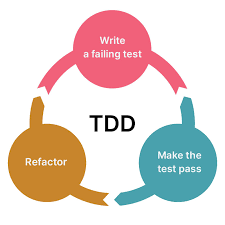Embracing Test-Driven Development (TDD): A Paradigm Shift in Software Engineering
 Joel Inyang
Joel Inyang
Test-Driven Development (TDD) is a software development approach that flips the traditional development process on its head. Rather than writing code first and then testing it, TDD advocates for writing tests before the code is even implemented. This paradigm shift brings about numerous benefits, including increased code quality, better maintainability, and a more robust software architecture.
The TDD Process:
Receive Requirements:
- Start with a clear understanding of the requirements for the feature or functionality you are about to implement. This could come in the form of user stories, specifications, or any other relevant documentation.
Write Failing Test First:
This is the cornerstone of TDD. Instead of immediately jumping into writing application code, you begin by creating a test that defines a function or improvements of a function, which should fail initially since the code to satisfy the test hasn't been implemented yet.
For instance, if you are tasked with creating a function that adds two numbers, your initial test might look like this (in a testing framework like
unittestfor Python):import unittest class TestAdditionFunction(unittest.TestCase): def test_add_two_numbers(self): result = add(3, 4) self.assertEqual(result, 7)Write Code to Pass Test:
With the failing test in place, the next step is to write the minimum amount of code necessary to make the test pass. In the case of our example, you would implement the
addfunction to return the sum of two numbers.def add(a, b): return a + b
Code Passes Test:
- Execute the test again. If the test passes, it means that your code is working correctly according to the defined requirements.
Improve the Workable Code:
- Now that you have a passing test and functional code, you can focus on improving the code. This might involve refactoring for better readability, optimizing performance, or adding additional features.
Advantages of TDD:
Early Detection of Bugs:
- TDD helps catch bugs early in the development process. Since tests are written before the code, any deviation from the expected behavior is identified immediately.
Improved Code Design:
- Writing tests first forces developers to think about the design of their code from the perspective of its usage. This often leads to cleaner and more modular code.
Faster Development Cycles:
- TDD can lead to faster development cycles in the long run. Although writing tests initially might seem time-consuming, it helps prevent time spent debugging and fixing issues later in the development process.
Increased Confidence in Code Changes:
- Having a comprehensive suite of tests gives developers confidence when making changes to the codebase. If a test fails after a modification, it indicates a regression, prompting a quick fix before the code is merged.
Challenges and Best Practices:
Learning Curve:
- TDD might have a learning curve for developers who are new to the approach. It requires a mindset shift towards test-first thinking.
Striking a Balance:
- Striking the right balance between writing enough tests and avoiding over-testing can be challenging. Focus on testing critical paths and edge cases.
Continuous Integration:
- Incorporating TDD into a continuous integration workflow is crucial. Automated builds and tests ensure that the codebase remains stable.
Refactoring Safely:
- While refactoring is a part of TDD, it's essential to do it safely. Ensure that your tests provide adequate coverage to catch regressions.
Conclusion:
Test-Driven Development is not just a testing technique; it's a development methodology that fosters a disciplined and structured approach to building software. By writing tests first, developers can create a safety net for their code, enabling them to refactor and enhance features confidently. Embracing TDD requires practice, but the long-term benefits in terms of code quality, maintainability, and developer confidence make it a valuable investment for software engineering teams.
Subscribe to my newsletter
Read articles from Joel Inyang directly inside your inbox. Subscribe to the newsletter, and don't miss out.
Written by
